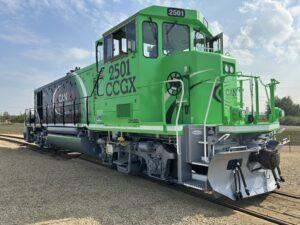Advancing the Zero Emission Fleet of the Future
Cando is redefining what is possible in Canadian rail operations through Li-Ion 2025, a pioneering project to electrify industrial switching using lithium-ion battery technology. By retrofitting a legacy, non-tier-compliant diesel locomotive into a zero-emission, fully electric unit, Cando has engineered a scalable and high-performance alternative tailored to closed-loop rail systems across Canada. This is more than a locomotive upgrade. It is a bold step toward industrial rail decarbonization.
Purpose-built for switching environments, the battery-powered locomotive matches the performance of diesel units while eliminating emissions, reducing noise, and removing exhaust-related wildfire risk. It directly contributes to reductions in both Scope 1 and Scope 3 greenhouse gas emissions, supporting the sustainability goals of Cando and its customers.
Supported by $2 million in funding from Emissions Reduction Alberta, the project is gaining national attention for its innovation, adaptability, and environmental leadership. Once deployed, each locomotive is expected to reduce up to 470 tonnes of CO₂e per year, cut energy costs by 60 percent, and decrease maintenance needs by 40 percent. The retrofit model offers a viable transition path for Canada’s fleet of industrial locomotives, including more than 2,000 switchers currently in operation, setting the stage for a cleaner and more cost-effective future in rail.
The retrofit was complete in early 2025 and the locomotive has been undergoing field testing. Cando held a celebration event and unveiling in September of 2025. We are now utilizing and evaluating the technical performance of the battery-powered locomotive and supporting charging infrastructure in a real-world switching environment at our Southlands Terminal.
Introducing the Zero Emission Fleet of the Future!

Why did we choose a battery powered locomotive?
Why did we choose a Lithium-Ion (Li-Ion) battery?
Where will the battery come from? Are all materials being sourced within Alberta and/or Canada?
Will the battery be able to perform in the cold climates of Alberta/Canada?
What are the environmental benefits?
How big is the market for battery powered switching locomotives?
What is the timeline for the project?
What does this mean for Cando’s operations/customers?
July 12, 2023 – ERA Announcement
April 11, 2024 – Q1 2024 Progress Report
July 8, 2024 – Q2 2024 Progress Report
September 1, 2024 – July/August 2024 Report
January 21, 2025 – Charging Station Installed
June 2025 – Cando CEO Brian Cornick Operates Battery Locomotive in the Field
July 9, 2025 – Cando Announces Celebration and Unveiling Event for September at Southlands Terminal
Sept 10, 2025 – New electric-powered locomotive designed for harsh winters unveiled near Edmonton | CBC News
From Vision to Reality – Watch our Story